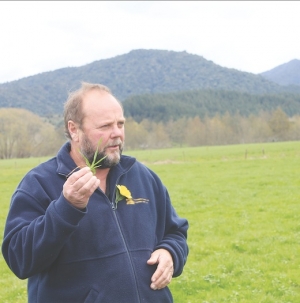Hawkins addressed 40 farmers last week at the DairyNZ flood recovery field day held on Suzanne Pasley and Barry Latimer’s 364ha farm southwest of Whangarei. He told attendees to act quickly on flood damaged pastures if they wanted to bounce back quickly.
Dirt and silt can shut down plants, inhibiting photosynthesis he says.
Plans of action for dealing with flood damaged pastures can be categorised three ways: flood washed pasture, pasture covered with 1-5cm of silt, and pasture under 5cm or more silt.
When little to no debris remains on paddocks, farmers should dislodge anything still remaining. This can be done by putting cows on affected paddocks before mowing anything left over, Hawkins says. “Pasture cut by a mower will put down new roots and put up new shoots cutting the effects of the dirt.”
He recommends following this up with an application of nitrogen and monitoring weeds.
When pasture is covered by silt thicker than an index finger, little can be done except to apply some form of fertiliser, then seed it with a short term Italian ryegrass-chicory mix and push it up the list as a cropping paddock.
Options are not as clear-cut when floodwaters leave a low level of silt on the ground, Hawkins says.
As lightly silted paddocks aren’t likely to have the same uniformity of damage as those with heavy silting, a judgment call is required on whether to completely renovate the pasture or just adopt a heavier grazing and topping regime. Considerations include the length of time the pasture has been under water and the ratio of Poa annua and other low value grasses in the sward.
Farmers can use a perennial ryegrass with an endophyte mixed with chicory to fill in pasture followed up by fertiliser and weed monitoring.
One thing all flood affected farmers should consider is an extra fertiliser application says Hawkins.
Potash, sulphur and nitrogen were often washed away by floodwaters, and silt does not provide much nutritional value. “Unless the silt has been washed from another farm it’s likely to be clay – low in nitrogen, sulfur, potash and other key elements.”
He suggests running a soil test after the initial nitrogen application to establish what other elements are needed.
Farmers might also need to deal with higher weed burdens. Pennyroyal, alligator weed, parsley dropwort, willowweed and creeping buttercup often appeared in pastures as the sward opened due to previous flooding.
Catch them now while they are small he advises. “It’s better to control them as seedlings than as established weeds so spray early.” He acknowledges that the exact chemicals needed vary depending on the type of weeds present and the type of crop the weeds are infesting.
While it pays to deal with weeds sooner than later, farmers shouldn’t try to re-sow pastures too soon after floods, especially at the start of winter. Some Northland farmers had already re-sown paddocks in August says Hawkins, even though the area was still in winter.
While grass needs time to germinate it also needs rising soil temperatures: many rye varieties take 12-24 days to germinate if sown in soil at 5-10oC. “Soil temperatures should be 12oC and rising.”
Pasture reseeded in August may also need to deal with extra rain. “In some situations grasses planted in September are more likely to be ready to be put back into the cycle earlier than those planted in August.”
















